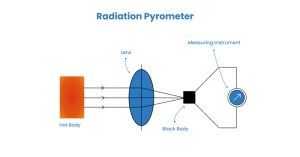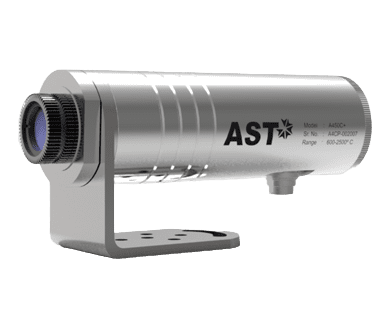Introduction
In the intricate landscape of industrial processes, few parameters carry as much weight as accurate temperature measurements. Picture this:
- The precision required in metallurgical processes
- The delicate balance needed in pharmaceutical manufacturing
- The optimal conditions crucial for electronic components
In each of these scenarios, the key to success lies in understanding and controlling temperature – and that’s where pyrometers come into play.
Importance of Accurate Temperature Measurements
At the core of efficient and reliable industrial operations is the ability to measure temperature with precision. Temperature isn’t just a number on a screen; it’s a critical factor influencing various processes’ quality, safety, and efficiency. Whether it’s ensuring the structural integrity of materials in aerospace engineering or maintaining the efficacy of drugs in pharmaceuticals, accurate temperature measurements form the bedrock of success.
The Role of Pyrometers in Various Industries
Enter pyrometers, the unsung heroes of temperature measurement. These devices, ranging from the humble yet dependable thermocouple to the cutting-edge infrared pyrometer, are the eyes that industries use to perceive the thermal aspects of their operations. Found in sectors as diverse as manufacturing, energy, and research, pyrometers are indispensable tools in the pursuit of precision. They provide the means to navigate the challenging terrain of high temperatures, non-contact measurements, and diverse material properties.
Purpose of the Guide: Helping Readers Choose the Right Pyrometer
As we delve into the intricacies of pyrometry, this guide seeks to empower you – the reader – with the knowledge to make informed decisions. Selecting the right pyrometer is not a one-size-fits-all endeavor; it’s a tailored process that hinges on understanding your unique requirements. The purpose of this guide is to demystify the world of pyrometers, unravel the complexities, and provide you with a roadmap to choose the perfect tool for your specific application.
Understanding Your Application Requirements
In the realm of temperature measurement, precision begins with a keen understanding of the specific demands of your application. Let’s break down the crucial elements that will guide you in choosing the right pyrometer tailored to your needs.
Defining the Temperature Range
Temperature ranges are the starting point in the quest for an effective pyrometer. Low-temperature applications typically involve temperature measurements below 300°C (572°F). Think food processing, where precise temperature control is vital for product quality. Medium-temperature applications span the range of 300°C to 1000°C (572°F to 1832°F), common in industries like ceramics manufacturing. On the other hand, high-temperature applications soar above 1000°C (1832°F) and find their place in intense environments like metal smelting.
2. Examples of Industries Corresponding to Different Temperature Ranges
- Low-Temperature Applications (Below 300°C):
- Food Processing: Ensuring food safety and quality through controlled temperatures.
- Pharmaceuticals: Temperature-sensitive processes in drug manufacturing.
- Medium-Temperature Applications (300°C to 1000°C):
- Ceramics Manufacturing: Firing processes demand precise temperature control.
- Automotive: Heat treatment of components in manufacturing.
- High-Temperature Applications (Above 1000°C):
- Metal Smelting: Extreme heat is required for melting and refining metals.
- Aerospace: High-temperature processes in the production of aircraft components.
Emissivity Considerations
1. Explanation of Emissivity and Its Impact on Measurements
Emissivity is a crucial factor in the accuracy of temperature measurements. It refers to an object’s ability to emit thermal radiation. Different materials have different emissivity values, and understanding this concept is fundamental to obtaining precise temperature readings. A high-emissivity material, for example, is an efficient emitter of thermal radiation and, thus, an easier target for accurate temperature measurement.
2. How to Determine Emissivity for Different Materials
Determining emissivity involves understanding the material’s surface properties. Some materials have known emissivity values, while empirical testing may be necessary for others. Many pyrometers allow users to adjust emissivity settings, offering flexibility in accommodating diverse materials. Charts and databases are available to provide emissivity values for common materials, aiding in the accurate calibration of your pyrometer.
Environmental Conditions
1. Discussing Factors like Humidity, Dust, and Ambient Temperature
Temperature measurement doesn’t happen in isolation; it unfolds within the context of the environment. Humidity, dust, and ambient temperature are environmental factors that can significantly impact the performance of a pyrometer. High humidity levels, for instance, can interfere with infrared measurements, while dust particles can obstruct accurate readings. Ambient temperature variations may affect the overall functionality of the pyrometer, making it crucial to consider these factors during selection.
2. How Environmental Conditions Can Affect Pyrometer Performance
In environments with high humidity, water vapor in the air can absorb and emit infrared radiation, leading to inaccurate readings. Dust particles in the line of sight between the pyrometer and the target can also cause measurement errors. Ambient temperature fluctuations can affect the pyrometer’s calibration and response time. Understanding these influences is key to choosing a pyrometer that can withstand and perform optimally in the specific conditions of your workspace.
As you navigate the complexities of your application requirements, keep these factors in mind. In the next section, we’ll explore the various types of pyrometers and their applications, providing insights into the tools that best meet your temperature measurement needs.
Types of Pyrometers and Their Applications
As we venture deeper into pyrometers, we must acquaint ourselves with the various types available and their specific applications. Each type has unique strengths and limitations, making the right selection crucial for achieving accurate temperature measurements in diverse settings.
Infrared Pyrometers
1. Operating Principles
Infrared pyrometers, often hailed as the workhorses of non-contact temperature measurement, operate on the principle of detecting infrared radiation emitted by an object. The device captures the thermal radiation and translates it into temperature readings through sophisticated algorithms. This non-contact approach makes infrared pyrometers invaluable when direct physical contact is impractical or challenging.
2. Applications and Limitations
Infrared pyrometers find applications across a spectrum of industries. In manufacturing, they play a pivotal role in processes like metalworking, ceramics production, and glass manufacturing. Infrared pyrometers are also widely used in energy production, such as monitoring furnace temperatures in power plants. However, it’s essential to note that atmospheric conditions, reflective surfaces, and the emissivity of the target material can influence the accuracy of infrared pyrometers.
Thermocouple Pyrometers
1. Overview of Thermocouple-Based Temperature Measurement
Thermocouple pyrometers leverage the Seebeck effect, where a temperature difference generates a voltage. This voltage is then used to calculate the temperature. These pyrometers typically involve direct contact with the target material, making them suitable for scenarios where physical touch is feasible.
2. Suitable Applications and Considerations
Thermocouple pyrometers shine in applications demanding real-time temperature readings. Foundries and metalworking industries often employ thermocouple pyrometers for their durability and quick response times. However, their physical contact requirement limits their use in certain situations. Additionally, they may need recalibration over time due to the gradual wear and tear of the thermocouple wires.
Radiation Pyrometers
1. Non-contact Temperature Measurement Using Thermal Radiation
Radiation pyrometers excel in non-contact temperature measurement by detecting the thermal radiation emitted by an object. These pyrometers are particularly valuable in high-temperature environments where direct contact is impractical or unsafe.

2. Industries Where Radiation Pyrometers Excel
Industries dealing with extreme temperatures benefit greatly from radiation pyrometers. Steel production, glass manufacturing, and semiconductor processing are examples. Their non-contact nature allows temperature measurement in harsh conditions, ensuring accurate readings without compromising safety or efficiency.
Advanced Technologies (e.g., Fiber Optic Pyrometers, Two-Color Pyrometry)
1. Brief Explanation of Cutting-Edge Pyrometric Methods
Advancements in pyrometric technologies have given rise to innovative solutions like fiber optic pyrometers and two-color pyrometry. Fiber optic pyrometers utilize optical fibers to transmit temperature information, making them resistant to electromagnetic interference and suitable for challenging environments. Two-color pyrometry enhances accuracy by measuring temperature at two different wavelengths, compensating for variations in emissivity and atmospheric conditions.
2. Specialized Applications for Advanced Technologies
Fiber optic pyrometers find applications in industries with high electromagnetic interference, such as induction heating. Two-color pyrometry is beneficial when precise temperature measurements are critical, such as in research and development laboratories.
Understanding the nuances of each pyrometer type equips you with the knowledge needed to select the right tool for your specific application. In the next section, we’ll explore the factors influencing pyrometer performance, delving into response time, calibration procedures, and maintenance tips to ensure the ongoing accuracy and reliability of your temperature measurements.
Factors Influencing Pyrometer Performance
Now that we’ve laid the groundwork on the types of pyrometers and their applications let’s turn our attention to the critical factors that influence their performance. Achieving precise and reliable temperature measurements goes beyond selecting the right type of pyrometer; it involves understanding and managing factors such as response time, calibration, and maintenance.
Response Time
1. Importance of Quick and Accurate Temperature Readings
In the realm of temperature measurement, time is often a crucial factor. In various industries, processes unfold rapidly, requiring quick and accurate temperature readings for effective control. Consider, for instance, a manufacturing line where timely temperature adjustment ensures the final product’s quality and efficiency. The response time of a pyrometer directly influences its ability to provide swift and accurate temperature readings, making it a key parameter for consideration.
2. How Response Time Varies Among Different Pyrometer Types
Different pyrometer types exhibit varying response times, influenced by their operating principles and design. Infrared pyrometers, known for their non-contact nature, generally boast faster response times than thermocouple pyrometers involving physical contact. Understanding the specific time requirements of your application enables you to select a pyrometer that aligns seamlessly with the pace of your processes.
Calibration Procedures
1. Regular Calibration for Maintaining Accuracy
Maintaining the accuracy of temperature measurements over time necessitates regular calibration. Calibration ensures that the pyrometer continues to provide precise readings by aligning its measurements with a known standard. Regularity in calibration is paramount, especially in dynamic industrial environments where factors like wear and tear can impact the instrument’s accuracy.
2. Calibration Methods and Frequency Recommendations
Pyrometers typically come with user-friendly calibration processes, and adhering to the manufacturer’s guidelines is essential for reliable temperature measurements. Calibration methods vary but often involve comparing the pyrometer readings to those of a reference standard. The calibration frequency depends on factors such as usage, environmental conditions, and the criticality of temperature accuracy. While some pyrometers may require calibration every few months, others may be calibrated annually.
Maintenance Tips
1. Cleaning and Handling Precautions
Proper maintenance is the key to prolonging the life and accuracy of your pyrometer. Regular cleaning of lenses and sensors is crucial to prevent dust or debris from affecting measurements. Handling precautions also play a significant role – avoiding physical damage and extreme temperatures contributes to the instrument’s longevity.
2. Common Issues and Troubleshooting Techniques
Despite meticulous care, pyrometers may encounter issues. Understanding common problems and having troubleshooting techniques at your disposal is essential. Issues such as inaccurate readings can be resolved through recalibration, while issues with response time involve checking for obstructions in the pyrometer’s line of sight.
Navigating the intricacies of response time, calibration, and maintenance ensures that your pyrometer consistently delivers accurate and reliable temperature measurements. As we wrap up this comprehensive guide, you now possess the insights needed to choose the right pyrometer for your application and maintain its optimal performance over time. Armed with this knowledge, may your temperature measurements be precise, your processes efficient, and your industrial endeavors a testament to the art and science of pyrometry.
In temperature measurement, this guide has illuminated the significance of pyrometers as indispensable tools shaping precision in diverse industries. We’ve navigated a comprehensive journey from understanding application intricacies to exploring the nuances of various pyrometer types and delving into factors influencing their performance. As you embark on your own endeavors, armed with insights, your temperature measurements may be precise and reliable. In the dynamic dance of industrial processes, let your pyrometer be the trusted ally, seamlessly merging technology and expertise to pursue excellence.







